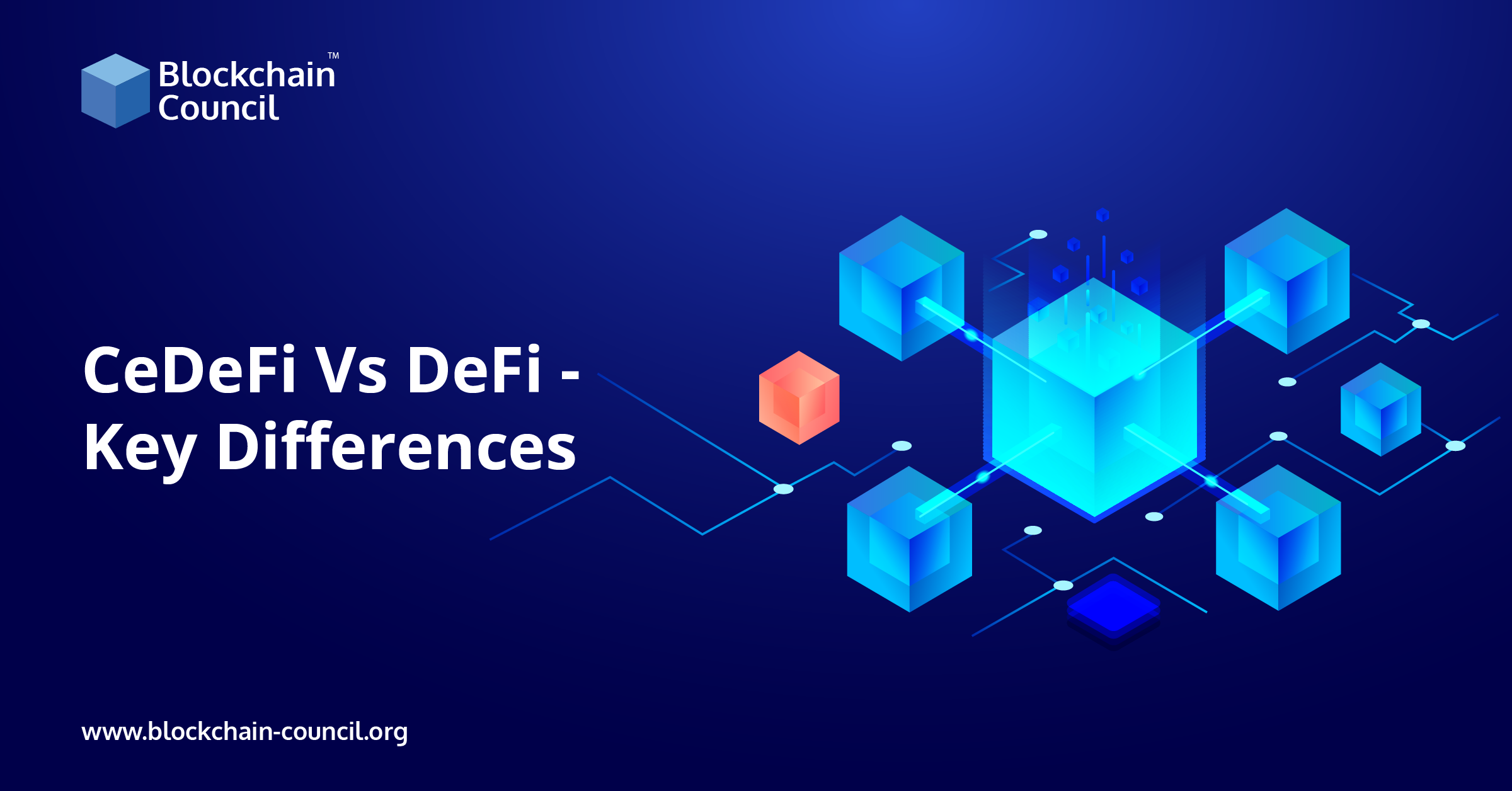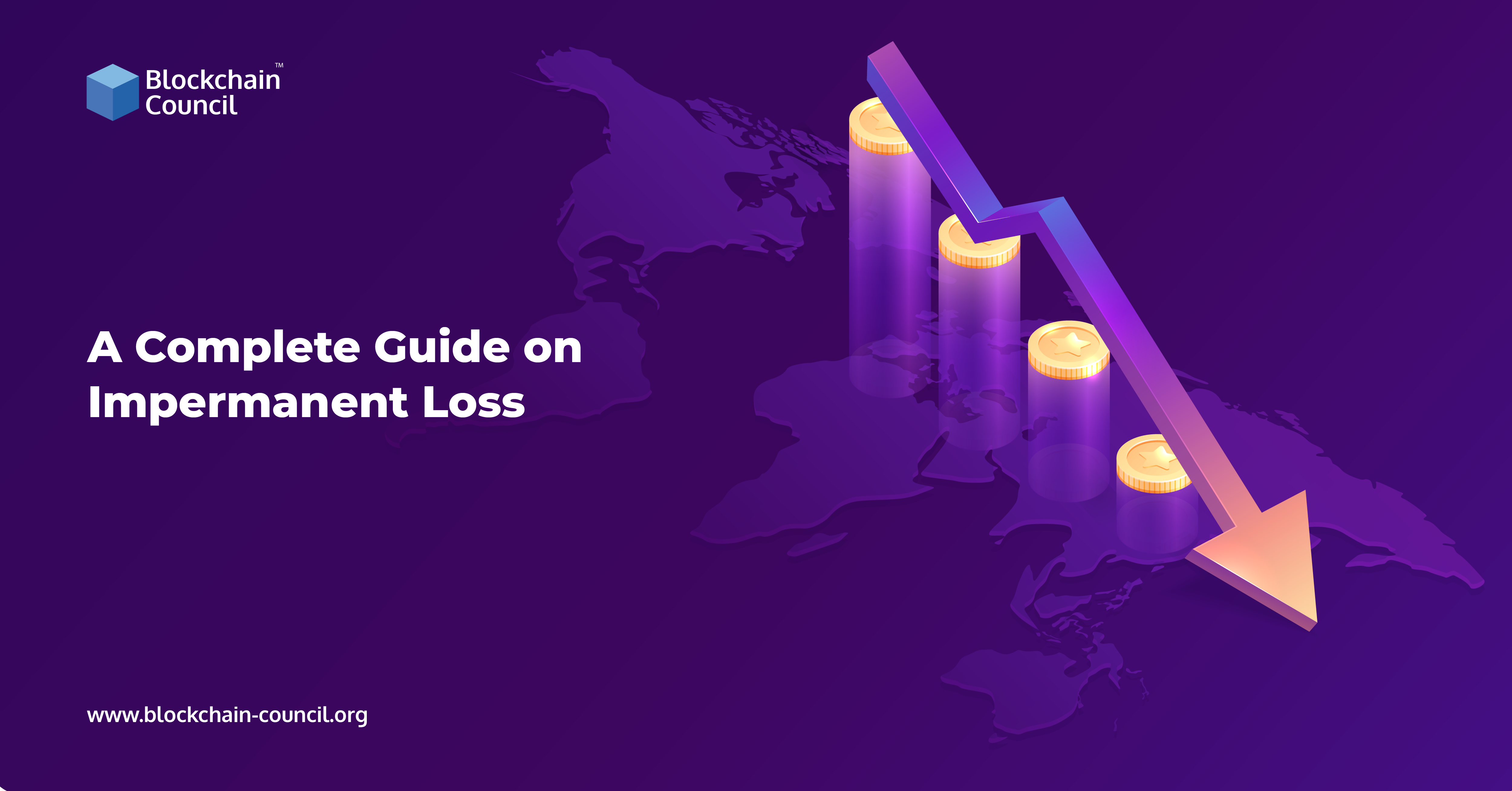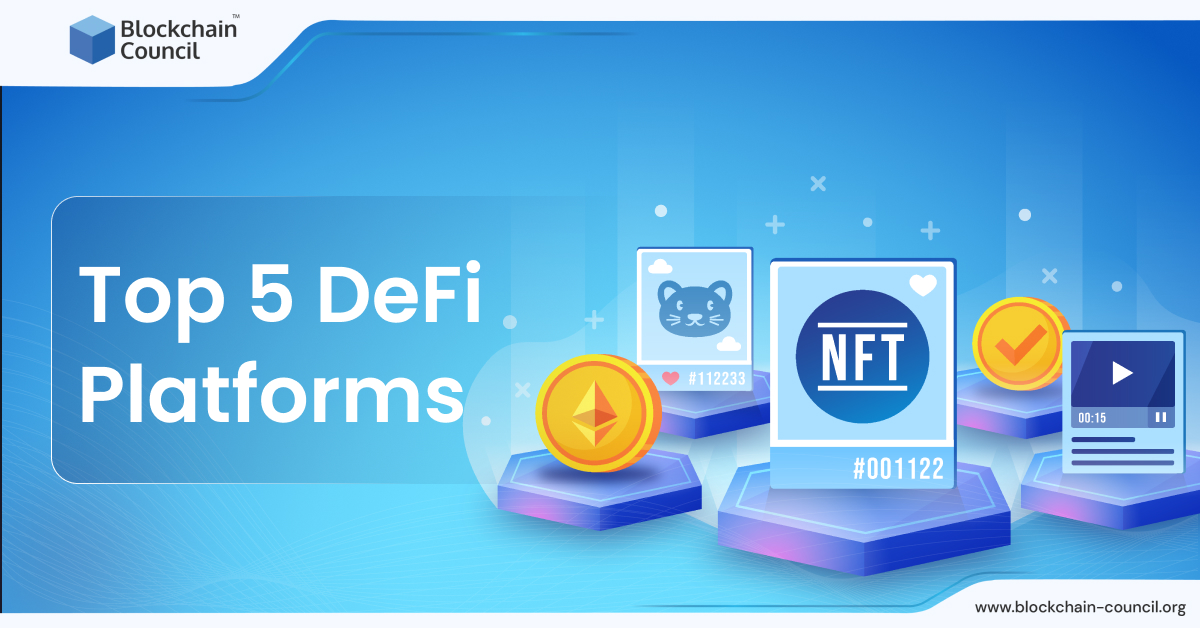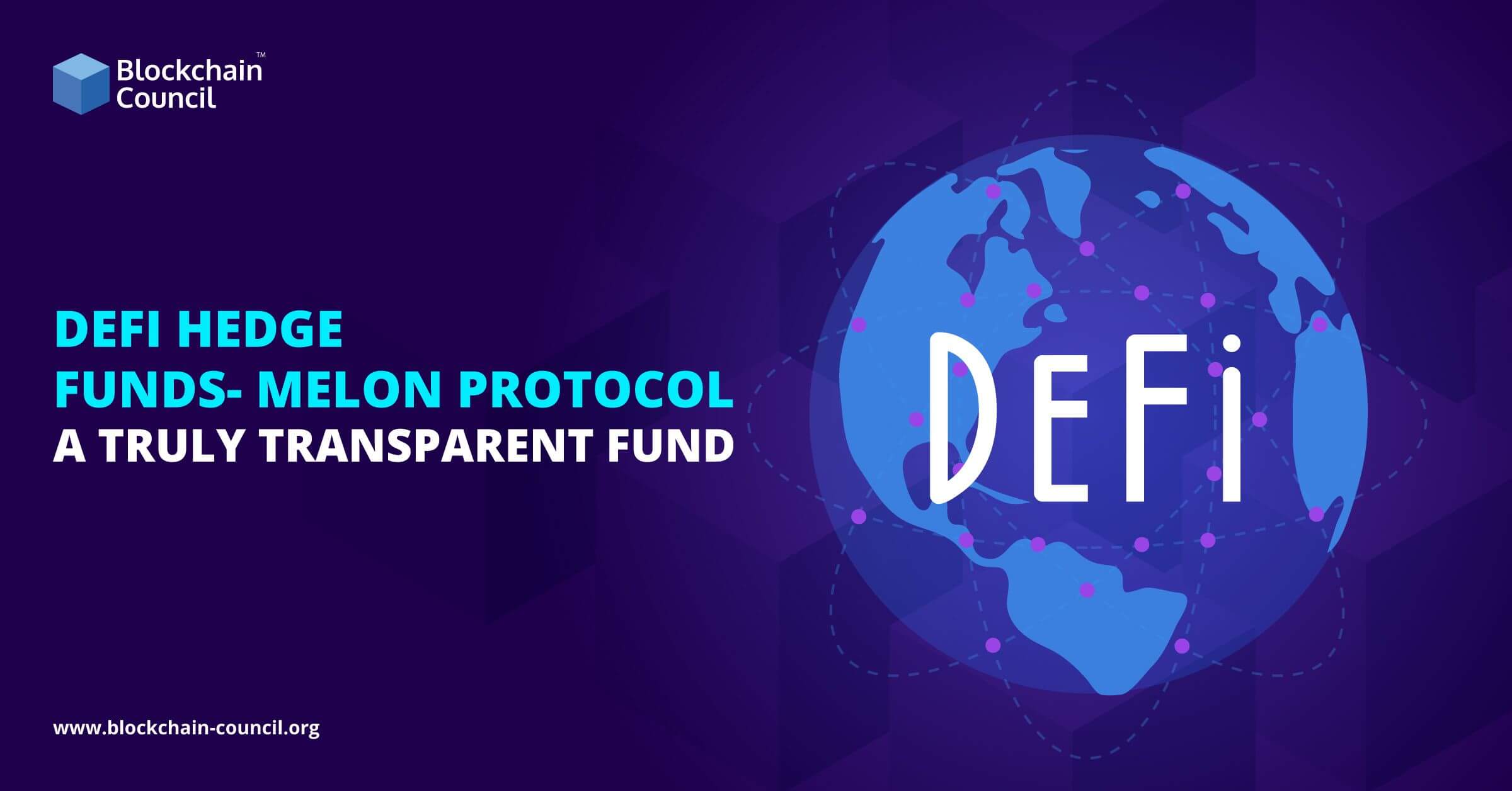
- Ayushi Abrol
- April 21, 2022

The shifting dynamics of the financial ecosystem are the most serious challenge for most people worldwide. At its launch, DeFi (Decentralized Finance) seemed to offer a lot of promise for better openness in the global financial landscape. On the other side, the deployment of centralized-DeFi could lead to new financial benchmarks. As a result, the CeDeFi Vs DeFi debate is gaining traction and capturing the attention of an increasing number of individuals worldwide.
Blockchain technology is being employed in many applications in today’s society. Getting a Blockchain degree and understanding the foundations is a good idea, but it can also help you get a job in the field.
The goal of both decentralized and centralized finance is the same. They intend to popularize cryptocurrency trading and increase trading volume. However, the methods used by these two ecosystems to achieve their goals differ.
What Exactly Is DeFi?
The usage of technology in financial services is not fresh. In today’s banks and other financial services firms, automation is employed to complete the majority of acquisitions. To consummate a transaction, companies must also traverse the legalese of several countries, overlapping financial markets, and differing regulations. DeFi put technology at the vanguard of financial transactions with its stack of popular software conventions and shared blockchains on which to establish them. Any Blockchain developer or professional can walk you through the process. Consumers can use several programs with centralized financing, just like with DeFi.
What Exactly Is CeDeFi?
The Binance Smart Chain is where CeDeFi started in the cryptocurrency world. Comparing CeDeFi to DeFi, on the other hand, is meaningless because DeFi has its own set of enticing qualities. CeFi, on the other hand, is likely to be a formidable opponent for DeFi. Consequently, CeDeFi remains a viable choice for DeFi ventures looking to accelerate their growth.
CeDeFi is a platform that enables you to trade approved tokens and projects. A respectable centralized exchange bears the task of regulating CeDeFi despite its vulnerabilities and fundamentally disruptive behaviors.
CeDeFi will also contribute to overcoming DeFi’s single project selection issues. CeDeFi, on the other hand, requires the user to use CeFi to accept several tokens or yields simultaneously.
When it comes to the two most well-known perks, CeDeFi, on the other hand, has some critics. Critics say that compensating centralized exchanges encourages people to pump the coins listed on the CEX. CeDeFi users will focus on utilizing it for this purpose as a result. The loss of adaptability in working on many projects with DeFi, on the other hand, isn’t always a problem.
What Was CeDeFi’s Role in the Scene?
The CeDeFi concept was born with the Binance Good Chain in the crypto world. Yet, there is no such stuff as a level in the CeDeFi Vs DeFi comparison because DeFi has its own set of unique features. CeFi, on the other hand, is ready to take on DeFi’s present powerful adversaries. As a result, CeDeFi appears to be the most promising option for DeFi operations to continue their golden run.
CeDeFi allows approved tokens or initiatives to be traded. CeDeFi is maintained by a reputable centralized trade, even though it has flaws and potentially dangerous characteristics.
CeDeFi will also aid in overcoming DeFi’s limitations on the number of single endeavors. CeDeFi, on the other hand, allows customers to use CeFi to earn several tokens or yields at the same time. CeDeFi, on the other hand, has received some criticism for its two most prominent features. Critics point out that rewarding centralized exchanges helps to maintain the CEX’s capacity for pumping funds. As a result, CeDeFi’s customers would continue to support the company for this specific reason. However, DeFi’s lack of flexibility in dealing with several single endeavors does not hold in all situations.
In the DeFi vs. CeDeFi discussion, it’s also worth noting that DeFi’s capital pools can be used to participate in various initiatives. On the other hand, customers do not have to worry about fund custody or central authority. Critics of CeDeFi also point out that with CeDeFi, clients can only expose an asset they want to keep for the long term. Customers wouldn’t be able to rush into the market to buy BNB on the spur of the moment, reducing portfolio shift or rebalancing friction.
CeFi’s Advantages
Centralized Exchange (CEX)
Users submit funds to a standard cryptocurrency exchange, such as Binance, Kraken, or Coinbase, and the exchange manages them in an internal account. Even though funds are housed on the exchange, they are maintained outside of users’ control and are exposed to threats if the exchange’s security procedure may fail.
Resultantly, the centralized exchanges have been targeted by various security attacks. Customers on centralized exchanges are comfortable revealing personal information and placing funds in the custody of these organizations because they believe central exchanges are trustworthy.
Furthermore, large exchanges have entire departments with customer support staff available to assist customers. The high quality of customer service gives the consumer a sense of security, reassuring them that their finances are excellent.
The Versatility Of Fiat Transition
Centralized services offer more flexibility than decentralized services when talking of conversion from cash to bitcoin and vice versa. Converting bitcoin to fiat normally necessitates the use of a centralized institution; nevertheless, DeFi services do not provide as much flexibility as fiat. In the Centralized Finance (CeFi) environment, customer onboarding is straightforward and can improve the customer experience.
Cross-Chain Services
LTC, XRP, BTC, and other coins generated on autonomous blockchain platforms are supported by CeFi services. Due to the delay and difficulty of performing cross-chain exchanges, DeFi services do not handle these coins. CeFi can tackle this problem by securing funds from many blockchains. Many of the most often moved and highest-market-cap coins operate on separate blockchains and do not follow interoperability standards; therefore, this is a huge benefit for CeFi.
DeFi’s Advantages
Permissionless
To use DeFi, users do not need permission. To utilize CeFi’s services, consumers must first undergo a KYC process, which requires them to give personal information or make a financial deposit.
Users can use a wallet to access the services without providing individual data or depositing money with DeFi. DeFi is open to everyone, without any restrictions or discrimination.
Individuals who want to layer on a decentralized platform can do so without restriction. The products developed as part of the DeFi ecosystem are meant to complement one another. DeFi products are often characterized as money legos because of this.
Trust
An important advantage of using DeFi services is that you don’t have to rely on them to provide what they promise. Users can check that DeFi services are working properly by looking through their code and using external tools like Etherscan to determine if an action was completed correctly.
Rapid Innovation
The Decentralized Finance Ecosystem continually improves existing capabilities while also experimenting with new ones. From a build-centric environment to a diverse ecosystem with ground-breaking financial services, the DeFi space has evolved. In functionalities where centralized financial services have developed, the DeFi space has attempted to provide alternate means to manage the issue.
To get around DeFi’s inability to support the transfer of conflicting cryptocurrencies like BTC, solutions like tBTC and WBTC, which are compatible with decentralized protocols, act as tokens pegged to the value of BTC. It allows DeFi users to access Bitcoin without utilizing the token directly through DeFi.
Understanding CeDeFi Vs DeFi
One of the most notable differences between centralized and decentralized finance is that in CeFi, the system is controlled, whereas, in DeFi, the system is unregulated. In centralized finance, the exchanges are in charge of safeguarding the users’ funds. The idea underpinning DeFi, on the other hand, is that transactions will be pleased with the outcome of smart contracts (a contract among two parties that imposes certain guidelines of discussion when a specific circumstance is satisfied). Put another way; the users are in charge of their finances and activities. It is feasible to block trading and place restrictions on users in CeFi.
In the case of decentralized finance, however, this is not conceivable. In contrast to decentralized finance, CeFi does not require authorization. CeFi stands out in two ways: first, it enables the easy and seamless transformation of fiat currency to cryptocurrency and vice versa, and second, it facilitates cross-chain exchange for numerous cryptocurrencies, demonstrating cryptocurrency interoperability.
Thus, if you think you need to understand CeDeFi Vs DeFi, you can examine the DeFi spectrum in greater detail. From highly decentralized to fully centralized environments, the DeFi spectrum covers it all. To properly compare DeFi vs. CeDeFi, let us examine the individual phases within the spectrum.
Inflation
Inflation is defined as the depreciation of a basic currency supply due to the addition of a new currency supply. While inflation is described as reducing a currency’s buying power, the connection between supply and inflation is not always evident; the money supply can sometimes increase without creating inflation.
Central banks retain the capacity to create fiat money in CeFi, and inflation is frequently measured against the value of a meaningful basket of consumer goods, referred to as a consumer price index. The asset supply of numerous cryptocurrencies is susceptible to alter in the DeFi certificate universe. Bitcoin (BTC) is likely to run into a situation wherein supply has a hard cap but the economic activity it needs to support does not, resulting in monetary scarcity.
Furthermore, without a block reward and hence no inflation, Bitcoin, or blockchains, in particular, may be exposed to security flaws. It’s unclear whether BTC and other cryptocurrencies face severe income disparities due to the fiat system’s inflation. There is no evidence that cryptocurrency will solve this issue.
Costs Of Transactions
To minimize spam, transaction fees in DeFi and blockchains in principle are crucial. The CeFi Financial institutions, on the other hand, can choose to offer transaction services at no cost because they can count on anti-money laundering (AML) verifications of their clients (or are compelled by governments to provide some services for free).
Definitive DeFiction
The main entry on the DeFi spectrum refers to actual DeFi projects that provide a degree of decentralization. True DeFi projects usually have a specific type of creator who is in charge of deploying the code. Nonetheless, no one can tamper with the code after the code has been deployed. Customers have the option of viewing supply codes in real DeFi developer mode.
Customers can also anticipate the intended behavior while comprehending personal funds management. Customers can also choose the conditions under which they can withdraw funds after they have been used. The majority of real DeFi projects are currently running on Ethereum. In true DeFi programs, however, Serum on Solana is an exception.
Market Hours Are Nonstop
The New York Stock Exchange and the Nasdaq Stock Exchange, for instance, are the two most important trading venues in the United States, with hours of operation ranging from 9:30 a.m. to 4:00 p.m. Eastern Time Monday through Friday.
Most, if not all, DeFi markets are available 24 hours a day, seven days a week because of the 24/7 nature of blockchains. As a result, DeFi eliminates pre-and post-market trading, but CeFi has thin liquidity on a range of items during these times.
These blockchains give pseudo-anonymity rather than providing actual anonymity. Because centralized exchanges with anti-money laundering restrictions are often the only practical option for converting money into cryptocurrency assets, they can reveal address ownership to law enforcement.
CeDeFi
CeDeFi is the opposite extreme of the DeFi spectrum. It’s mostly a centralized token-harvesting approach that has nothing to do with DeFi certificate. Customers can use CEX platforms, which are comparable to Binance, to stake BNB or other tokens. Customers are then given farmed tokens from Binance-sponsored ventures.
Customers do not have to use CeDeFi initiatives to obtain tokens. Furthermore, CeDeFi projects do not include any on-chain functionalities. It primarily serves as a safe alternative for clients afraid of DeFi to farm their tokens of certain decentralized ventures.
Tabular Difference Between CeFi & DeFi
| Categories | DeFi | CeFi |
| Inflation | Asset supply of numerous cryptocurrencies is susceptible to alter in the DeFi universe | Central banks retain the capacity to create fiat money |
| Costs of transactions | It is crucial | Can be done at no cost |
| Definitive Definition | Yes | No |
| Non-stop market hours | 24 hours | Closes at particular time |
| CeDeFi | Opposite | Similar concept |
Final Takeaway
Finally, with Binance’s recent initiatives, the CeDeFi Vs DeFi argument has started to gain traction. The Binance Good Chain is quite similar to Ethereum in allowing easy migration of projects like CREAM. Binance Good Chain offers some form of DeFi in the most basic sense, yet there are concerns about its decentralization with the Proof of Stake Authority agreement. Additionally, DeFi certification and CeFi share the same goal: to serve customers with high-quality monetary goods and services while simultaneously generating economic growth.
Resultantly, it is believed that these two distinct yet interwoven financial systems will survive and mutually benefit. A few synergy opportunities are highlighted in the section below.
Even though CeFi and DeFi have varying processes and user behaviors, CeFi’s stress testing could teach CeFi a lot. While CeFi depends on circuit breakers to control excessive asset fluctuation (markets stop trading when volatility reaches predetermined levels), DeFi seems to have avoided such interruptions thus far, which could help CeFi better understand its limits.





































































 Guides
Guides News
News Blockchain
Blockchain Cryptocurrency
& Digital Assets
Cryptocurrency
& Digital Assets Web3
Web3 Metaverse & NFTs
Metaverse & NFTs
